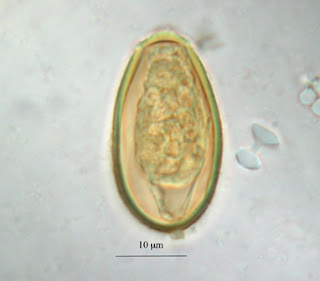****** FASCIOLA HEPATICA ******
Common name: Sheep liver fluke
Disease: Fascioliasis, liver rot
Halzoun or pharyngeal
fascioliasis
– laryngopharyngitis due to eating raw infected sheep or goat liver; the young
adult flukes attached to the pharynx, larynx, Eustachian tube or palates. Signs
and symptoms include: dysphagia, dyspnea, deafness and asphyxia
Cutaneous fascioliasis – an ectopic
foci wherein the flukes lodged themselves in the subcutaneous tissue causing an
oval or round reddish–brown discoloration with associated pain and itchy
sensation.
Morphology:
1. Adult
has smaller oral sucker and a slightly bigger ventral sucker. The pharynx is
well–developed and following the short esophagus. The intestinal ceca
bifurcates which is characteristically dendritic and this extends down to the
posterior end. It also has a highly branched paired testis which lies one
behind the other. Vitellaria is also highly branched; the branched ovary is
situated at the right side of the ventral sucker and opposite it, it is the
coiled uterus.
2. Ova
measure about 150u, immature when laid
1st Intermediate
Host: Lymnea philippinensis
2nd Intermediate
Host: Aquatic vegetation like water cress
Life cycle
****** CLONORCHIS SINENSIS ******
Common name: Chinese
liver fluke
Oriental
liver fluke
Disease: Clonorchiasis
Morphology
1. Adult
measure 10–25 mm, spatulate organism attenuated anteriorly and rounded
posteriorly. The integument is aspinose. The oral sucker is slightly larger
than the ventral sucker. The most characteristic feature of the worm are the
large deeply lobed or branched testes which are situated one behind the other
in the posterior 3rd of the body, with branches extending into the
lateral fields. The vitellaria are delicate granular aggregates in the lateral
field.
2. Egg
measure about 29–35u, broadly ovoidal with moderately thick light yellow brown
shell provided with a distinct convex operculum which fits into a rimmed
extension of the shell. They have thick posterior and with comma– shaped
operculum (old fashioned electric bulb). They are embryonated when laid and
contain mature miracedium.
1st Intermediate
Host:
Melanoides tuberculatus;
Crithidia, Thiara, Bulimus
2nd Intermediate
Host: Fresh water fishes
Life cycle
****** OPISTORCHIS FELINEUS *******
Common name: Cat liver fluke
Disease: Opistorchiasis
Morphology:
1. Adult
measures from 7–12 mm, lanceolated in shape with a subterminal oral sucker, the
ventral sucker is almost of equal size as the oral sucker, the diagnostic
feature is the lobed pair of testes arranged obliquely to each other, on the
lateral field of the worm or transversely compressed vitelline follicles;
simple intestinal ceca.
2. Ova
measures 30 x 10u, it is elongatedly oval in shape & resembles the
Clonorchis ova except for the shape & absence of the prominent shoulder
rim.
1st Intermediate
Host:
Melanoides tuberculatus
2nd Intermediate
Host: fresh fish (Cyprinoid)
Life cycle
******* OPISTORCHIS VIVERRINI *******
1. An
important human infection in Thailand.
2. Similar
to O. felineus except for its greater proximity on the ovary and testes, fewer
clusters of aggregated vitellaria.
3. Does
not cause any specific symptoms
















No comments:
Post a Comment